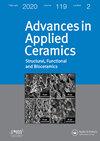瓷砖作为可持续、功能性和绝缘材料,可减轻火灾损害
IF 1.6
4区 材料科学
Q3 MATERIALS SCIENCE, CERAMICS
引用次数: 2
摘要
由于其较低的成本和功能特性,建筑行业越来越多地采用合成有机聚合物(SOP)材料用于衬里、内饰和非承重结构部件。虽然标准操作程序在环境条件下具有良好的性能和特性,但相同的材料在中高温(如建筑物火灾)下通常表现不佳。事实上,与混凝土和瓷砖等传统建筑材料不同,大多数标准操作程序在高温下往往会燃烧和分解,这不仅会导致火灾,而且会对疏散和消防作业产生不利影响。从消防工程的角度来看,本文验证了一个假设,即在火灾条件下,瓷砖(CTs)有望优于sop和常用的隔热材料作为饰面和衬里材料。因此,本研究展示了在25°C至1000°C的温度范围内,常用的ct, sop和绝缘体的行为之间的彻底比较。然后,本文分析已发表的CT模型,借助机器学习(ML)导出温度相关的材料模型。这项工作的发现提倡使用ct作为有利的饰面和内饰材料,以实现改进的结构防火性能和火灾响应管理,而不是sop,复合材料或绝缘材料。这项工作的结果预计会引起建筑师、急救人员、建筑官员、消防和结构工程师的兴趣。本文章由计算机程序翻译,如有差异,请以英文原文为准。
Ceramic tiles as sustainable, functional and insulating materials to mitigate fire damage
ABSTRACT Owing to their lower costs and functional properties, the construction industry has been increasingly adopting synthetic organic polymer (SOP) materials into linings, interiors and non-load bearing structural components. While SOPs have favourable properties and characteristics at ambient conditions, the same materials often perform poorly under moderate-to-elevated temperatures such as that arising from a building fire. In fact, most SOPs tend to combust and decompose at elevated temperatures which, unlike traditional building materials such as concrete and ceramic tiles, is proven to not only contribute to the fire but also to adversely affect evacuation and firefighting operations. From a fire engineering perspective, this paper tests a hypothesis in which ceramic tiles (CTs) are expected to outperform SOPs and commonly used insulations as finishing and lining materials under fire conditions. As such, this study showcases a thorough comparison between the behaviour of commonly available CTs, SOPs and insulations in temperatures ranging between 25 and 1000°C. Then, this paper analyses published CT models to derive temperature-dependent material models with the aid of machine learning (ML). Findings of this work advocate the use of CTs as favourable finishing and interior lining materials to enable realising improved structural fire performance and fire response managements, as opposed to SOPs, composites or insulations. The outcome of this work is expected to be of interest to architects, first responders, building officials, fire and structural engineers.
求助全文
通过发布文献求助,成功后即可免费获取论文全文。
去求助
来源期刊

Advances in Applied Ceramics
工程技术-材料科学:硅酸盐
CiteScore
4.40
自引率
4.50%
发文量
17
审稿时长
5.2 months
期刊介绍:
Advances in Applied Ceramics: Structural, Functional and Bioceramics provides international coverage of high-quality research on functional ceramics, engineering ceramics and bioceramics.
 求助内容:
求助内容: 应助结果提醒方式:
应助结果提醒方式:


